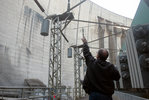
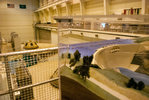
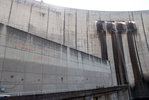
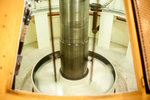
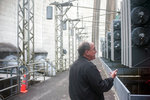
The city of Tacoma relies on hydroelectricity for more than half of its power supply. Of its four projects, none produce more electricity than those on the Cowlitz River.
The Mayfield and the Mossyrock dams produce enough power for more than 135,000 Pacific Northwest homes. The two dams work in synchronicity to ensure the right amounts of water are moving through the system to keep power production and water levels where they’re supposed to be.
Over the last several years, Tacoma Power has been gradually updating several major elements of the Mossyrock Dam at the west end of Riffe Lake. Currently, a 300-ton crane is parked at the top of it where crews are working to remove the two headgates. Headgates control the water flowing through the dam and entering the turbine inside the powerhouse. Tacoma Power plans to remove and refurbish them one at a time, a move they hope will save ratepayers close to $1 million.
Tacoma Power generates about 40 percent of its energy needs from its four hydroelectric projects around the state, most of which comes from the Mossyrock and Mayfield dams.
The Mossyrock Dam creates the 23.5-mile-long Riffe Lake. While the dam’s primary function is for power production, it also plays an important role in flood prevention. For example, when the 2006 flood raised water levels to 25.2 feet in the Randle area, the Mossyrock dam held that water back in Riffe Lake.
“In 2006 they stored all of it,” Cowlitz River Assistant Project Manager Chad Chalmers
Inside the powerhouse, which sits at the base of the 606-foot-tall Mossyrock Dam, a loud hum of an enormous spinning turbine echos through the cavernous building.
In 2006, the city of Tacoma approved a $50 million project to replace much of the antiquated technology that had reached their lifespans. At several areas through the dam, equipment that has been online since the dam went into operation in 1968 sits in stark contrast to the modern counterparts that are replacing it.
Inside the control room, green panels with analog displays sit next to new gray ones that utilize a combination of digital and analog meters.
There are two turbines inside the powerhouse, both of which were replaced in 2010 and 2011, respectively.
Currently, only one of the dam’s turbines is in operation. The unseasonably dry winter and spring has put water flows at levels much lower than normal. It’s the kind of thing officials aren’t used to seeing until typically closer to early July.
“We’re running at about 3,000 cubic feet per second,” Cowlitz River Project Manager Larry Burnett said. “Normally, for this time of year, we’d be at 5,000. We could even drop to 2,500.”
There is room for one more turbine to be installed, but that’s not likely to happen anytime soon. The utility has considered adding another one, but with a contract to purchase power from the Bonneville Power Administration good until 2038, the cost is too prohibitive.
“Eventually it’ll happen. I’m guessing it’ll be after I’m retired.” Burnett said.